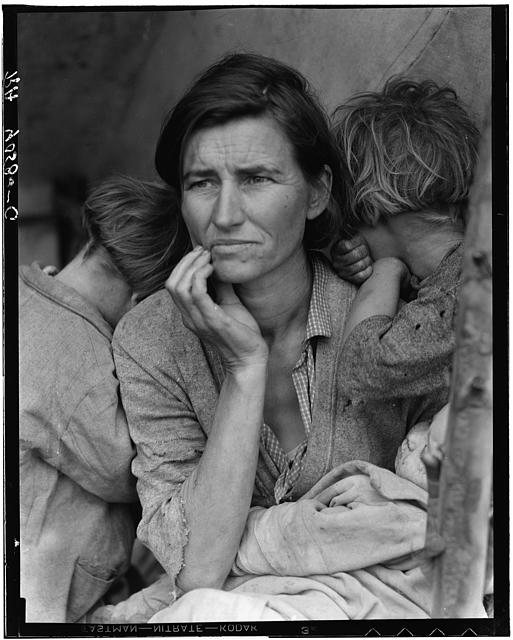Though I'm not what you'd call a connoisseur of famous photographers, I recognized one of Lange's most prominent works immediately: Migrant Mother.
This photo is a particular favorite of mine, though I've never known its name before today. From my research, it's a Depression-era photo of a mother living in a desert tent with her children, eating only frozen vegetables from nearby fields and birds her children killed.
It is a particularly striking image, I think, because it is in black and white. The era during which this photo was taken was characterized by a metaphorical dark cloud over the previously abundant America. The stark, simple contrast between the subjects and the dull background further implicates the conditions under which they lived.
This photo is harder for me to explain, in terms of my interest in it, because the contrast is not as artful and the frame is much more cluttered, but something about it just gets me. Yes, it's busy, but look closer. In fact, the only truly busy section of this photo is the middle row of it. The roof and the ground are fairly simple, which only adds to the nostalgic chaos of the storefront. Even in the mess of imagery, there seems to be a balance, and black and white suits it for this reason, because the lack of color equalizes the madness. If there were color, there would be too much chaos, and I think Lange, given the option of color back then, would have understood.
And finally, this photo, which seems almost entirely opposite of the one above. Though the subject is centered, usually a taboo framing for a learned photographer, its unusual triangle shape offsets the awkwardness of the cliche. Even as it is unusual, however, it also seems a very natural position to find this boy in. The contrast in this picture, like the one above, is not as stark as Migrant Mother, but neither is the subject. The focus at the bottom of the picture is sharp, which gives an even more interesting perspective. Also, the contented yet amused expression on the boy's face is classic. This picture would lose a lot of its comfortable simplicity if it were in color, and a lot of its intimacy.
What makes a good black and white image?
I think a photo with good, strong contrast or subject makes a perfect candidate for black and white.
What does your eye gravitate to when color is absent?
Whatever the subject is. Color is usually a distraction and is used in combinations with other colors, but black and white forces you to really take in what a photo is displaying.
How does the style of the images (subjects, light, etc) lend to being a good B&W image?
The subject has to be simple and the lighting has to be higher for a good B&W image, because the lack of color contrast can sometimes make it difficult to discern between different elements of a photo, especially if it is too chaotic or complex.


